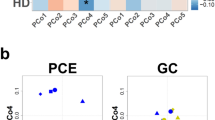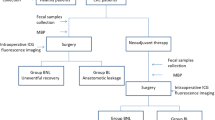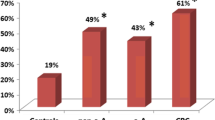Abstract
Since the metabolic activity of the colonic flora plays a definite role in colon cancer and an increased incidence of this disease is reported after cholecystectomy, we studied the metabolic activity of the colonic flora in a group of postcholecystectomy patients and matched controls by measuring, as representative end products of the bacterial metabolism, their fecal bile acids (BA), fecal 3-methylindole (SK) and indole (IN), and respiratory methane and hydrogen. Patients had significantly higher SK and lower IN, and, among BA, higher lithocholic (LCA) and chenodeoxycholic acid concentrations and LCA/deoxycholic acid ratio in the stools than controls. Similar differences from controls were reported for colon cancer. Comparable bacterial metabolic activities are thus operative in the large bowel of postcholecystectomized and colon cancer patients. This supports the biological plausibility of the association of cholecystectomy and colon cancer.
Similar content being viewed by others
References
Linos DA, Beard CM, O'Fallon WM, Dockerty MB, Beart RW Jr, Kurland LT: Cholecystectomy and carcinoma of the colon. Lancet 2:379–383, 1981
Vernick LJ, Kuller LH, Lohsoonthorn P, Rycheck RR, Redmond CK: Relationship between cholecystectomy and ascending colon cancer. Cancer 45:392–395, 1980
Vernick LJ, Kuller LH: Cholecystectomy and right-sided colon cancer: An epidemiological study. Lancet 2:381–383, 1981
McMichael AJ, Potter JD: Host factors in carcinogenesis: Certain bile-acid metabolic profiles that selectively increase the risk of proximal colon cancer. J Natl Cancer Inst 75:185–191, 1985
Moorehead RJ, McKelvey STD: Cholecystectomy and colorectal cancer. Br J Surg 76:250–253, 1989
Hill MJ, Drasar BS, Williams REO, Meade TW, Cox AG, Simpson JEP, Morson BC: Faecal bile-acids and clostridia in patients with cancer of the large bowel. Lancet 1:535–539, 1975
Mastromarino A, Reddy BS, Wynder EL: Metabolic epidemiology of colon cancer: Enzymic activity of fecal flora. Am J Clin Nutr 29:1455–1460, 1976
Gorbach SL, Goldin BR: The intestinal microflora and the colon cancer connection. Rev Infect Dis 12 (suppl 2):S252-S261, 1990
Scheline RR: Metabolism of foreign compounds by gastrointestinal microorganisms. Pharm Rev 25:451–523, 1973
Goldin BR, Gorbach SL: The relationship between diet and rat fecal bacterial enzymes implicated in colon cancer. J Natl Cancer Inst 57:371–375, 1976
Malagelada JR, Go VL, Summerskill WHJ, Gamble WS: Bile acid secretion and biliary bile acid composition altered by cholecystectomy. Am J Dig Dis 18:455–459, 1973
Hepner GW, Hofmann AF, Malagelada JR, Szczepanik PA, Klein PD: Increased bacterial degradation of bile acids in cholecystectomized patients. Gastroenterology 66:556–564, 1974
Pomare EW, Heaton KW: The effect of cholecystectomy on bile salt metabolism. Gut 14:753–762, 1973
White BA, Lipsky RL, Fricke RJ, Hylemon PB: Bile acid induction specificity of 7 alpha-dehydroxylase activity in an intestinalEubacterium species. Steroids 35:103–109, 1980
Aries VC, Crowther JS, Drasar BS, Hill MJ, Williams REO: Bacteria and the etiology of cancer of the large bowel. Gut 10:334–335, 1969
Hill MJ, Drasar BS, Aries V, Crowther JS, Hawksworth G, Williams REO: Bacteria and aetiology of cancer of large bowel. Lancet 1:95–100, 1971
Simon GL, Gorbach SL: The human intestinal microflora. Dig Dis Sci 31:147S-162S, 1986
Reddy BS, Weisburger JH, Wynder EL: Effects of high risk and low risk diets for colon carcinogenesis on fecal microflora and steroids in man. J Nutr 105:878–884, 1975
Reddy BS, Wynder EL: Large bowel carcinogenesis: Fecal constituents of populations with diverse incidence rates of colon cancer. J Natl Cancer Inst 50:1437–1442, 1973
Hill MJ: The role of colon anaerobes in the metabolism of bile acids and steroids, and its relation to colon cancer. Cancer 36:2387–2400, 1975
Hill MJ, Taylor AJ, Thompson MH, Wait R: Fecal steroids and urinary volatile phenols in four Scandinavian populations. Nutr Cancer 4:67–73, 1982
Turjman N, Goodman GT, Jaeger B, Nair PP: Diet, nutrition intake, and metabolism in populations at high and low risk for colon cancer. Metabolism of bile acids. Am J Clin Nutr 40 (suppl):937–941, 1984
Reddy BS, Wynder EL: Metabolic epidemiology of colon cancer. Fecal bile acids and neutral sterols in colon cancer patients and patients with adenomatous polyps. Cancer 39:2533–2539, 1977
Faivre J, Boutron MC: Precancerous lesions of the colorectum. Descriptive epidemiology and diet-related aetiological factors.In Causation and Prevention of Human Cancer. MJ Hill, A Giacosa (eds). Dordrecht, Kluver Academic Publishers, 1990, pp 33–47
Owen RW, Dodo M, Thompson MH, Hill MJ: Fecal steroids and colorectal cancer. Nutr Cancer 9:73–80, 1987
Haines A, Metz G, Dilawari J, Blendis L, Wiggins H: Breath-methane in patients with cancer of the large bowel. Lancet 2:481–483, 1977
Karlin DA, Jones RD, Stroehlein JR, Mastromarino AJ, Potter GD, Breath methane excretion in patients with unresected colorectal cancer. J Natl Cancer Inst 69:573–576, 1982
Karlin DA, Mastromarino AJ, Jones RD, Stroehlein JR, Lorentz O: Fecal skatole and indole and breath methane and hydrogen in patients with large bowel polyps or cancer. J Cancer Res Clin Oncol 109:135–141, 1985
Reddy BS: Diet and excretion of bile acids. Cancer Res 41:3766–3768, 1981
Reddy BS, Sharma C, Simi B, Engle A, Laakso K, Puska P, Korpela R: Metabolic epidemiology of colon cancer: Effect of dietary fiber on fecal mutagens and bile acids in healthy subjects. Cancer Res 47:644–648, 1987
Nair PP: Role of bile acids and neutral sterols in carcinogenesis. Am J Clin Nutr 48:768–774, 1988
Narisawa T, Magadia NE, Weisburger JH, Wynder EL: Promoting effect of bile acids on colon carcinogenesis after intrarectal instillation ofN-methyl-N′-nitro-N-nitrosoguanidine in rats. J Natl Cancer Inst 53:1093–1097, 1974
Reddy BS, Narasawa T, Weisburger JH, Wynder EL: Promoting effect of sodium deoxycholate on colon adenocarcinomas in germfree rats. J Natl Cancer Inst 56:441–442, 1976
Reddy BS, Watanabe K, Weisburger JH, Wynder EL: Promoting effect of bile acids in colon carcinogenesis in germ-free and conventional F344 rats. Cancer Res 37:3238–3242, 1977
Levitt MD, French P, Donaldson RM: Use of hydrogen and methane excretion in the study of the intestinal flora. J Lab Clin Med 72:988–989, 1968
Pitt P, De Bruijn KM, Beeching MF, Goldberg E, Blendis LM: Studies on breath methane: The effect of ethnic origins and lactulose. Gut 21:951–954, 1980
Zuccato E, Andreoletti M, Bozzani A, Marcucci F, Velio P, Bianchi P, Mussini E: Respiratory excretion of hydrogen and methane in Italian subjects after ingestion of lactose and milk. Eur J Clin Invest 13:261–266, 1983
Levitt MD, Donaldson RM: Use of respiratory hydrogen (H2) excretion to detect carbohydrate malabsorption. J Lab Clin Med 75:937–945, 1970
Ceriani R, Zuccato E, Fontana M, Zuin G, Ferrari L, Principi N, Paccagnini S, Mussini E: Lactose malabsorption and recurrent abdominal pain in Italian children. J Pediatr Gastroenterol Nutr 7:852–857, 1988
Miller TL, Wolin MJ: Oxidation of hydrogen and reduction of methanol to methane is the sole energy source for a methanogen isolated from human feces. J Bacteriol 153: 1051–1055, 1983
Goto J, Hasegawa M, Kato H, Nambara T: A new method for simultaneous determination of bile acids in human bile without hydrolysis. Clin Chim Acta 87:141–147, 1978
Mussini E, Marcucci F, Canobbio ML, Geretto S, Poy F: Glass capillary separation and quantitative determination of free bile acids.In Recents Developments in Chromathography and Electrophoresis, Vol. 10. A Frigerio, M McCamish (eds). Amsterdam, Elsevier, 1980, pp 183–192
Wilpart M, Mainguet P, Maskens A, Roberfroid M: Mutagenicity of 1,2-dimethylhydrazine towardsSalmonella typhimurium, co-mutagenic effect of secondary bile acids. Carcinogenesis 4:45–48, 1983
Hiasa Y, Konishi Y, Kamamoto Y, Watnabe T, Ito N: Effect of lithocolic acid ondl-ethionine carcinogenesis in rat liver. Gann 62:239–245, 1971
Silverman SJ, Andrews AW: Bile acids: Comutagenic activity in theSalmonella-mammalian-microsome mutagenicity test: Brief communication. J Natl Cancer Inst 59:1557–1559, 1977
Kelsey MI, Pienta RJ: Transformation of hamster embryo cells by cholesterol-alpha-epoxide and lithocholic acid. Cancer Lett 6:143–149, 1979
Kulkarni MS, Cox BA, Yielding KL: Requirements for induction of DNA strand breaks by lithocholic acid. Cancer Res 42:2792–2795, 1982
Turjman N, Nair PP: Nature of tissue-bound lithocholic acid and its implications in the role of bile acids in carcinogenesis. Cancer Res 41:3761–3763, 1981
Moorehead RJ, Campbell GR, Donaldson JD, McKelvey STD: Relationship between duodenal bile acids and colorectal neoplasia. Gut 28:1454–1459, 1987
van der Linden W, Katzenstein B, Nakayama F: The possible carcinogenic effect of cholecystectomy. No postoperative increase in the proportion of secondary bile acids. Cancer 52:1265–1268, 1983
van der Werf SDJ, Huijbregts AWM, Lamers HLM, van Berge Henegouwen GP, van Tongeren JHM: Age dependent differences in human bile acid metabolism and 7a-dehydroxylation. Eur J Clin Invest 11:425–431, 1981
Nagengast FM, van der Werf SDJ, Lamers HLM, Hectors MPC, Buys WCAM, van Tongeren JMH: Influence of age, intestinal transit time, and dietary composition on fecal bile acid profiles in healthy subjects. Dig Dis Sci 33:673–678, 1988
Kay RM: Effects of diet on the fecal excretion and bacterial modification of acidic and neutral steroids, and implications for colon carcinogenesis. Cancer Res 41:3774–3777, 1981
Cummings JH, Wiggins HS, Jenkins DJA, Houston H, Jivraj T, Drasar BS, Hill MJ: Influence of diets high and low in animal fat on bowel habit, gastrointestinal transit time, fecal microflora, bile acid, and fat excretion. J Clin Invest 61:953–963, 1978
Lampe JW, Slavin JL, Baglien KS, Thompson WO, Duane WC, Zavoral JH: Serum lipid and serum bile acids changes with cereal, vegetable, and sugar-beet fiber feeding. Am J Clin Nutr 53:1235–1241, 1991
Michael AF, Drummond KN, Doeden D, Anderson JA, Good RA: Tryptophan metabolism in man. J Clin Invest 43:1730–1746, 1964
Zuccato E, Venturi M, Granelli P, Bertolo C, Rosina M, Pagani M, Mussini E, Zennaro F: Bacterial metabolism and colon cancer risk in postcholecystectomized patients.In Digestive Surgery: Liver and Biliary Tract. M Montorsi, F Zennaro (eds). Bologna, Monduzzi Editore, 1990, pp 321–325
Breuer NF, Katschinski B, Mortl E, Leder LD, Goebell H: Large bowel cancer risk in cholelithiasis and after cholecystectomy. Postmortem study. Digestion 40:219–226, 1988
Hladik V, Nozicka Z, Maslowska H: Colorectal carcinoma and cholecystectomy. Neoplasma 34:361–366, 1987
Cheah PY: Hypotheses for the etiology of colorectal cancer. An overview. Nutr Cancer 14:5–13, 1990
Author information
Authors and Affiliations
Rights and permissions
About this article
Cite this article
Zuccato, E., Venturi, M., Di Leo, G. et al. Role of bile acids and metabolic activity of colonic bacteria in increased risk of colon cancer after cholecystectomy. Digest Dis Sci 38, 514–519 (1993). https://doi.org/10.1007/BF01316508
Received:
Revised:
Accepted:
Issue Date:
DOI: https://doi.org/10.1007/BF01316508




